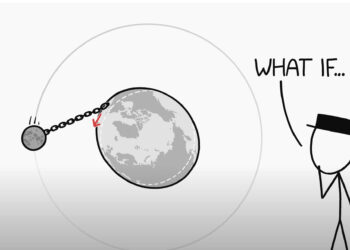
- Image by Shirin K. A. Winiger via Flickr
We live in a hyperlinked information world. Ever since the first <a ref=></a> combination was coded, we’ve been following, aggregating, and sharing links. They’re native to the Web, and increasingly expected even in rich displays on devices like the iPhone and iPad.
In fact, complaints arise from users when iPad apps don’t link enough. Joe Wikert, in reviewing the new Wired magazine app, complains that linking is underutilized and sporadically deployed, creating missed opportunities and an uneven user experience. His recommendation? “Here’s a simple rule they should follow: All URLs should open a link!”
However, my own experience with the iPad was that it failed to some degree because it was so distracting to use. Everything was just a gesture away — email, Web, movies, music, you name it. Hyperlinks to outside sources — that open Safari or iTunes or QuickTime — provide just another form of distraction on a device that promises a more immersive experience.
Marshall Kirkpatrick on ReadWriteWeb has an interesting essay along these lines entitled, “The Case Against Links.” To emphasize his point, he excised all links from the text, placing them at the bottom instead, ala footnotes. Frankly, I found this a little bothersome. For instance, when Kirkpatrick mentions his first source of information, I wanted to right-click on it to store it in a tab I could visit later. Instead, I had to scroll all the way down, ferret it out (since it had lost context), and then right-click on it. Compared to footnotes, inline links in expository writing reassure me that there’s some foundation for what the person is elaborating upon, and they’re more convenient. There is definitely an art to inserting these, as I hope I’ve learned over the years of doing the Scholarly Kitchen, but if you insert links well, they are better than footnotes, at least online.
But are they distracting nonetheless?
Of course, like many things, once you follow some links, you find that Nicholas Carr is the one sparking the debate with an essay entitled, “Experiments in delinkification.”
Compared with a footnote, Carr believes links are the bigger, stronger cousin:
The link is, in a way, a technologically advanced form of a footnote. It’s also, distraction-wise, a more violent form of a footnote. Where a footnote gives your brain a gentle nudge, the link gives it a yank. What’s good about a link – its propulsive force – is also what’s bad about it.
Carr argues that links add to an anti-intellectual feeling online because they “promote hurried, distracted, and superficial thinking online.” Other contributors to this sorry state include multimedia and multitasking.
Response to Carr’s essay has been forceful, with some accusing him of wanting to “unbuild” the Web.
But even the relatively retiring footnote has its detractors. Justice Stephen Breyer of the US Supreme Court, who prefers inline references, had this to say about footnotes in the realm of legal opinion:
It’s not to prove that you’re right: you can’t prove you’re right, there is no such proof. And it’s not to create an authoritative law review on the subject. Others are better doing that than I. It is to explain as clearly as possible and as simply as possible what the reasons are for reaching this decision. Others can then say those are good reasons or those are bad reasons. If you see the opinion in this way, either a point is sufficiently significant to make, in which case it should be in the text, or it is not, in which case, don’t make it.
Another judge, Richard Posner, makes a more pragmatic argument against footnotes:
The obvious objection to footnotes is that they force the reader to interrupt the reading of the text with glances down to the bottom of the page. They prevent continuous reading. In doing so they make the reader work harder for the same information.
And, of course, Noel Coward had this to say:
Coming across a footnote is like going downstairs to answer the doorbell while making love.
So, while inline references might make more sense for the reader (or at least two judges and one wit argue this point), and while footnotes may seem archaic online, are links really necessary and helpful?
Links are used by publishers, but they don’t help them make money. In fact, Jakob Nielsen has argued that because of links, 90% of the value of content sites accrue to search engines. So publishers might not be fans of links if they didn’t want to feed the search engines. But links are vital to good online prose — they make it more interesting, more modern, and more useful.
For academics, the footnote, the hyperlink, and the citation all have various uses. One of the first style conventions we had to absorb as the Web rolled out was how to represent URLs in our citation lists — whether they’re linked or not. Linking schemes from footnotes to PubMed and other databases (genetic, protein, and materials) have been prevalent for years and years.
Perhaps the most entertaining use of footnotes and marginalia comes in Edward Gibbon‘s “Decline and Fall of the Roman Empire.” This amazing history set a standard for citations as a rhetorical and historical tool as John Clive notes in his book “Not by Fact Alone”:
The footnotes [of Gibbon] must not be forgotten. . . . They contain those flashes of wit and humor that help to ease the reader’s long trek through the centuries, from the reference to the Abbé le Boeuf as “an antiquarian, whose name was happily expressive of his talents,” to the comment on the learned Origen, who, eager for perpetual chastity, thought fit to castrate himself “to disarm the tempter.”
Perhaps some resolution can be achieved by pondering the purpose of footnotes, inline citations, citations, and links. Mainly, writers have been seeking a way to add a dimension to our writing, a subtext if you will. Fiction writers deploy them, as well, often for that very reason. For scholars, that subtext can include reading lists, offhand observations, rich extensions of thought, tributes and acknowledgments, elaborations in shorthand, and other useful, additive devices.
Do they distract? Of course they do. That’s what footnotes, citations, and now links have been meant to do for decades, if not centuries. But it’s distraction through addition, if done well.
Are they anti-intellectual? Only if done poorly.
Actually, distraction might be quite pro-intellectual — it has a firm historical basis in footnotes and citations.
The challenge for users is to learn to manage this secondary layer of information. I manage hyperlinks by right-clicking on them and opening a separate tab beneath the one I’m currently on. I know I’ve captured the link, and I can look at it later.
Scholarly reading is often a form of information chasing. Links are the modern version of our classic prey. As readers, we just need to master modern hunting techniques.
Discussion
6 Thoughts on "Arguing Against Links: Are They Distracting, Counterproductive, and Anti-Intellectual?"
I think the question is, What about the gratuitous link? I have seen links to such well-known entities as Microsoft and, unbelievably, Thomas Jefferson. This is linking for the sake of linking. A writer can and should assume a certain level of knowledge among his or her readership. For the Scholarly Kitchen I would not distract anyone with links to Harold Varmus or the Library of Congress. It would be a terrible world if the NY Times found it necessary to provide a link to President Obama.
Joe Esposito
There have been a few studies done–I cannot find any of them right now–that show it isn’t linking that’s distracting and counterproductive, but rather the *style* applied to links (usually a bright color, and often underlined). These studies showed that when links were made to differ only slightly in appearance from the surrounding body text, they became significantly less distracting.
I find it interesting that when offered the choice, the vast majority of readers of articles accessed through ACS Publication’s Journals website tend to download the basic “dumb” PDF version vs the linked and otherwise digitally illuminated XML option.
For all the brouhaha re digital publishing in STM, what we are really doing is digital distribution and search-based indexing…once selected, a journal article is still very much locked into a 100 year old + user experience, interface, and enduser workflow.
Still trying to figure out is this just a habit, a vestige of concerns re limited bandwidth and latency, or a marked user preference for a traditional quiet/focused reading experience when doing serious research vs info grazing. And how the advent of new mobile platforms – a la Ipad – have the potential to change this.
![Reblog this post [with Zemanta]](http://img.zemanta.com/reblog_e.png?x-id=fcf22ed3-9d67-46f5-a405-f3c0ea3e2266)


